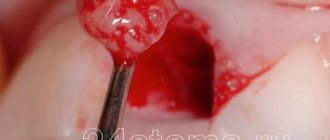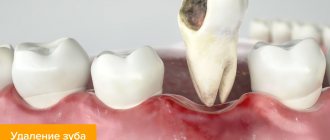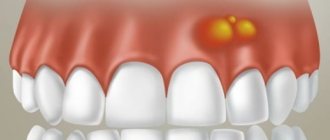From this article you will learn:
- Tooth pulled out, gums hurt: what to do.
- why gums hurt after tooth extraction: reasons,
- How many days should the pain last?
The article was written by a dental surgeon with more than 19 years of experience.
Many patients complain that their gums hurt in the first days after tooth extraction. Pain is the body's normal response to injury, and therefore mild pain that does not last long is normal. However, pain occurs not only as a consequence of injury to the bone and gums, but also because inflammation of the gums could develop after tooth extraction.
According to statistics, inflammation and improper healing of the socket after tooth extraction occurs in 3-5% of cases (but this applies to teeth of any location except wisdom teeth). But the removal of the eighth teeth leads to the development of complications in approximately 25-30% of cases. This article will help you understand the cause of the pain, whether your tooth socket is healing properly, and what to do if it becomes inflamed.
Type of gums after tooth extraction (normal) –
Please note that normally, the socket of each extracted tooth should be completely covered with a blood clot. The surface of the clot should first be an intense burgundy color, gradually becoming yellowish-whitish. What the sockets should look like at different times after extraction - see the article: → “Healing the sockets of extracted teeth: photo”
Content:
- Why do my gums hurt after tooth extraction?
- Self-medication during the recovery period as the main cause of pain
- How to treat gums at home
- Diseases that cause gum pain after tooth extraction
- How long does gum pain normally last after tooth extraction?
- When you need urgent dental care
Removal of an incisor, canine, or molar is a surgical operation during which a unit is removed from the alveolus.
It has to be done for various reasons. The complexity of the procedure depends not only on the anatomical structure of the roots, but also on the location of the operated area and the type of dental disease that has arisen. As a rule, the more the tooth hurts and the more extensive the swelling, the more difficult it is for the doctor to work.
This is due to the accumulation of exudate in soft tissues. But postponing extraction until later due to fear or other far-fetched reasons is unacceptable. Delay is fraught with periostitis, alveolitis and other dangerous complications.
Hematoma
In addition to alveolitis, another complication such as hematoma and suppuration of the hematoma occurs. At the same time, we see normal healing of the socket, but there is pronounced swelling and pain in the soft tissues (cheeks, along the transitional fold).
The main signs of a hematoma are:
- swelling of the cheek in the area of the extracted tooth or at the site of anesthesia;
- pain when touching the cheek;
- the cheek is warmer than the surrounding tissues;
- cyanosis appears on days 3-4;
- the temperature may rise.
There can be many reasons for the formation of hematomas, but the main ones are:
- vascular injury during anesthesia or removal of tooth fragments. All people have different vessels, and the surgeon cannot say with certainty where the vessel will go;
- problems with blood clotting (diabetes, leukemia).
Hematomas also cannot be treated at home. You definitely need to see a surgeon.
If the hematoma is relatively small and there are no signs of suppuration, then drugs are prescribed to resolve the blood. If the hematoma is large and there are signs of suppuration (fever, sharp pain, redness of the cheek and increased skin temperature, tissue tension), then an incision is made along the transitional fold, pus and excess blood are released, and drainage is placed in the wound. After a week, the wound heals, leaving a scar.
Home treatment of hematomas is fraught with the formation of abscesses and phlegmons, which may require external incisions and subsequent cosmetic surgeries, and in advanced cases can cause serious complications for the body as a whole.
Why do my gums hurt after tooth extraction?
Extraction is a serious intervention. The further the destroyed unit is located in the row, the more roots it has, the denser the bone, the more difficult it is to pull it out. It is especially difficult for a dental surgeon if the coronal part is significantly destroyed. Then you have to remove the sharp fragments.
If a granuloma is detected at the apex or there is an accumulation of pus in the capsule, two successive operations may be required - the first is aimed at removal, the second is aimed at washing out purulent masses and sanitation. Doctors often scrape out necrotic tissue from a bleeding socket. All these procedures contribute to additional trauma to the mucous membranes. It is not surprising that the patient experiences soreness during the healing period.
Dangerous complications of long-term pain
Ignoring pain and tissue swelling can lead to serious complications that may require surgery.
When the inflammatory process is advanced, purulent foci form in the tissues, increasing the risk of pus spreading through the bloodstream throughout the body. The development of phlegmon and destruction of the jawbone is likely. With a hematoma, a thickening of the clot may occur, which will inevitably lead to the need for surgical intervention, the appearance of scars and an increase in recovery time.
Self-medication during recovery as a source of the problem
Often patients do not ask the doctor what to do if they have pain. They begin to actively rinse the inflamed area, apply compresses to the injured area, and warm the cheek with a heating pad. All these actions are prohibited unless prescribed by a specialist.
Normally, a dense blood clot should form after surgery. It is an essential element of the healing process, as it covers the wound surface from pathogenic microorganisms. If you constantly rinse your mouth, the clot will not form or will resolve prematurely. Then damaged tissues will remain unprotected from infections and bacteria.
If you heat the area of inflammation, the swelling may increase. Applying compresses directly to mucous membranes often leads to a chemical burn. Therefore, if your gums hurt after tooth extraction, it is not advisable to experiment. The most reasonable thing is to visit a dentist and consult with him.
Causes
After a tooth has been removed, alveolitis of the socket often occurs. Certain factors may contribute to this:
- the blood clot, which prevents infection from entering the wound, has been destroyed;
- bone fragments, stone, plaque got into the hole during the removal procedure;
- the specialist did not clean the hole very well from granulations and granules;
- sterility was compromised;
- the removal was very traumatic;
- the patient did not follow all the doctor’s instructions;
- The patient's body is exhausted, immunity is quite low.
When a regular tooth or wisdom tooth has been removed, you should not rinse your mouth too vigorously, as there is a risk that the blood clot located in the socket will be washed out. The result is that microbes get inside and provoke an inflammatory process.
How to treat gums at home
The basic rule of home therapy is to follow all medical prescriptions. If there is a special anti-inflammatory medicine in the inflamed area, you should not remove it without permission due to the unpleasant taste or odor. The doctor will do this himself or will tell you exactly the day and time when it is necessary to remove the medicated compress.
Dentists often prescribe soda baths. To carry them out, you need to mix a teaspoon of baking soda with a glass of warm water. Keep the solution in your mouth without rinsing. This simple measure helps to quickly remove the purulent exudate.
It is very important to follow a gentle diet during the recovery period. If there is severe pain on the first day after surgery, it is permissible to take a painkiller. If the medicine does not help or reduces the uncomfortable symptoms only slightly, you should definitely seek qualified help.
A good healing effect is provided by antibacterial gels and ointments designed specifically for treating gums. They must be prescribed by a dental surgeon.
If the operation was difficult and the likelihood of postoperative complications is high, the doctor may prescribe oral antibiotics. Typically, dentists prefer broad-spectrum drugs. It is permissible to use them strictly according to the scheme selected by a specialist.
Early secondary inflammation
This complication can be caused by the use of adrenaline with an anesthetic solution in order to prolong pain relief. Despite the fact that adrenaline has a vasoconstrictor property, after 2 hours of use the opposite effect appears - the vessels dilate and bleeding develops. Bleeding is stopped by tightly closing the hole with gauze soaked in antiseptic.
Also, gums may bleed due to high blood pressure or failure to follow medical recommendations. For example, the patient begins to rinse his mouth ahead of time and independently remove the tampon from the hole. Such bleeding is usually stopped by reducing the pressure using sterile tampons.
Diseases that cause gum pain
Unfortunately, no one is immune from unpleasant consequences after tearing out a root unit. Much depends on metabolism (metabolism), existing chronic pathologies, age, the functioning of the immune system, the tendency to develop allergies - a huge number of factors influence the regeneration processes.
It is necessary to consider whether the person is taking any medications. After all, there are medications that inhibit the formation of a blood clot, prevent blood from clotting quickly, or increase blood pressure. All of these effects are unacceptable during recovery from extraction.
Among the main diseases causing complications after extraction:
- Periostitis. Inflammatory lesion of the periosteum. Most often it occurs due to immunodeficiency or advanced chronic pathologies of the oral cavity. It can also be triggered by hidden infections localized in the maxillofacial area. Periostitis causes inflammation of the soft tissues after the root unit is pulled out. A person’s body temperature rises and their general health worsens. He becomes lethargic and weak. At the same time, the cheek swells. To slow down the inflammatory process and reverse it as soon as possible, combined anti-inflammatory and antimicrobial therapy and oral sanitation are carried out. If the disease has spread to deep-lying tissues, the patient is most often hospitalized in a hospital to avoid abscess and phlegmon of the jaw.
- Alveolitis. Inflammation of the walls of the alveoli after surgery. The disease occurs when tissue healing is slow, there are necrotic areas, or an “empty” socket. First there is pain, then it is accompanied by bad breath. In the area of the torn unit, a light gray coating characteristic of pathology appears. It is difficult to remove. Therapy includes frequent washing of the wound with an antiseptic solution and oral administration of anti-inflammatory drugs selected by a specialist.
Considering the seriousness of these diseases, it is important to treat extraction responsibly. During the preparation period, you should undergo treatment of all existing pathologies of the oral cavity and high-quality sanitation and professional hygiene.
What to do if alveolitis begins?
As mentioned above, alveolitis is an inflammation of the tooth socket. Here, in addition to normal tissue swelling, you will also experience redness of the mucous membrane, acute pain, and an odor from the socket (as pus and food debris accumulate there). These symptoms are increasing every day.
Alveolitis cannot be treated at home. By taking antibiotics, ointments, rinses and other “home” measures, you can either achieve nothing at all, or transfer the process into a chronic form, when, with minimal symptoms, the bone in the area of removal will dissolve and as a result we will get a huge defect in the bone, which will be difficult to correct. Alveolitis in Samara should be treated only together with a surgeon, strictly adhering to his recommendations.
What does a surgeon do for alveolitis?
- Anesthesia is given;
- When everything has become numb, the surgeon cleans the tooth socket again (removes pus, tooth fragments or bones, if any, rinses the socket with solutions of antiseptics and antibiotics);
- After treating the wound, there are two options: some kind of drug can be put into the hole. Or they can simply fill it with fresh, clean blood and wait for a new clot to form;
- After cleaning, antibiotics, rinses, and epithelializing drugs are prescribed.
After such measures, a noticeable improvement occurs on the second or third day (pain and swelling begin to subside), but healing of the hole takes longer - up to three weeks.
How long does pain last normally?
When describing unpleasant sensations, clinic patients usually point to their aching nature. How long the discomfort lasts is determined by:
- where exactly the extracted tooth was located;
- how carefully the work was carried out;
- whether the patient carefully followed the doctor’s instructions received after the operation;
- what condition were the tissues and mucous membranes in before the start of dental therapy.
As practice shows, the hole normally bothers you for about two to four days. Every day the affected area becomes less and less sensitive. If after five days the discomfort does not subside, you should definitely consult a dental surgeon.
When you urgently need medical help
The reason to visit the dentist again is intense throbbing pain after extraction, swelling of the cheek, and the appearance of a specific (unpleasant) odor from the mouth. All these symptoms indicate the development of inflammation, which requires immediate correction. You should also not postpone your visit to the dental clinic if:
- strong painful pulsation persists for more than two days;
- accumulations of purulent masses appeared;
- pain radiates to the ear, chin, temporal area, bridge of the nose, forehead;
- the cheek is very swollen, it is impossible to touch it, since tactile contact increases the pain;
- body temperature has increased and remains high for more than one day;
- there is no blood clot on the alveolus, which should form in the next few hours after extraction;
- weakness appeared, performance after the operation decreased sharply, and the situation did not improve even a few days after the dental intervention.
You must not allow the infection to spread in your mouth. Attentive attention to your own well-being is the key to successful rehabilitation and rapid healing of the wound surface. By following the doctor’s prescriptions, you can greatly increase the chances of successful rehabilitation after extraction of a molar.
Infectious inflammations of the oral cavity
Although most doctors work conscientiously and live with the main precept of all medicine “do no harm,” there are still unscrupulous doctors. Such doctors can cause infection during tooth extraction because they violate antiseptic rules and perform poor-quality sanitation. Doctors’ mistakes can seriously undermine a patient’s health, and even a simple tooth extraction can lead to long and serious treatment. Such complications include: purulent-septic complications, complications associated with dry socket, osteomyelitis and abscess. Each of the complications is quite serious and requires immediate treatment. Therapy consists of a doctor prescribing antibiotics, and in cases such as osteomyelitis and abscess, surgical intervention is required.











